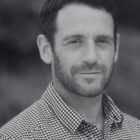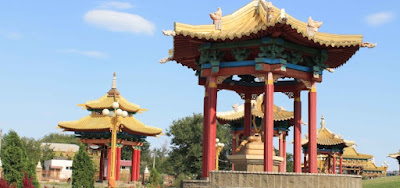 |
| The pleasures of the senses drag us through much misery and little satisfaction. |
Desire or
tanha (lit. "thirst," craving) in Pali is an important thing to understand. What is desire?
Kama tanha (craving for sensual pleasures) is very easy to understand. This kind of desire is wanting sense pleasures through the body or the other senses and always seeking things to excite or please our senses — that is sensual thirst.
We can really contemplate: What is it like when I have desire for pleasure? For example, when I am eating, if I am hungry and the food tastes delicious, I can be aware of wanting to take another bite.
 |
| Warm, vegan, gluten-free pizza, yum! |
Notice the feeling when tasting something pleasant. Notice wanting more of it. Don’t just believe this; try it out. Let’s not think we know it because it has been that way in the past. Try it out when next eating. Taste something delicious and see what happens: A desire (craving) arises for more. That is
kama tanha.
We also contemplate the feeling of wanting to become something. But if there is ignorance then when we are not seeking something delicious to eat or some beautiful music to listen to, we can be caught in a realm of ambition and attainment — the desire to become (bhava tanha).
We get caught in that movement of striving to become happy, seeking to become wealthy; or we might attempt to make our life feel important by endeavoring to make the world right. So note this sense of wanting to become something other than what we are right now.
Listen to the bhava tanha of our life:
- "I want to practice meditation so I can become free from my pain.
- I want to become enlightened.
- I want to become a monk or nun.
- I want to become enlightened as a lay person.
- I want to have a spouse and children and a profession.
- I want to enjoy the sense world without having to give up anything and become an enlightened arahant too."
When we get disillusioned with trying to become something then there is the desire to get rid of things (vibhava tanha). So we contemplate this desire, the craving to get rid of:
- "I want to get rid of my suffering.
- I want to get rid of my anger.
- I’ve got this anger, and I want to get rid of it.
- I want to get rid of jealousy, fear, and anxiety."
 |
| Motherfather, shut up! I want to be rid of... |
Notice this as a reflection on
vibhava tanha. We are actually contemplating that within ourselves which wants to get rid of things; we are not trying to get rid of
vibhava tanha.
We are not taking a stand against the desire to get rid of things, nor are we encouraging that desire. Instead, we are reflecting, "It’s like this; it feels like this to want to get rid of something; I’ve got to conquer my anger; I have to kill the Devil and get rid of my greed — then I will become..."
 |
| Hey, what if we calm down and fix it? |
We can see from this train of thought that becoming and getting rid of are very much associated.
Bear in mind though that these three categories of kama tanha, bhava tanha, and vibhava tanha are merely convenient ways of contemplating desire. They are not totally separate forms of desire but different aspects of it.
The second insight into the Second Noble Truth is: "Desire should be let go of." This is how letting go comes into our practice.
We have an insight that desire should be let go of, but that insight is not a desire to let go of anything. If we are not very wise and are not really reflecting in our mind, we tend to follow the "I want to get rid of, I want to let go of all my desires" — but this is just another desire.
However, we can reflect upon it; we can see the desire to get rid of, the desire to become, or the desire for sense pleasure. By understanding these three kinds of desire, we can let them go.
The Second Noble Truth does NOT ask us to think, "I have a lot of sensual desires" or "I’m really ambitious. I’m really bhava tanha plus, plus, plus!" or "I’m a real nihilist. I just want out. I’m a real vibhava tanha fanatic. That’s me."
The Second Noble Truth is not that. It is not about identifying with desires in any way; it’s about recognizing desire.
I used to spend a lot of time watching how much of my practice was desire to become something. For example, how much of the good intentions of my meditation practice as a monk was to become liked — how much of my relations with other monks or nuns or with lay people had to do with wanting to be liked and approved of. That is bhava tanha — desire for praise and success.
As a monk, we have this bhava tanha: wanting people to understand everything and to appreciate the Dharma. Even these subtle, almost noble, desires are bhava tanha.
Then there is
vibhava tanha (
craving for annihilation, nonbeing) in spiritual life, which can be very self-righteous: "I want to get rid of, annihilate, and exterminate these defilements."
I really listened to myself thinking, "I want to get rid of desire. I want to get rid of anger. I don’t want to be frightened or jealous any more. I want to be brave. I want to have joy and gladness in my heart."
This practice of Dharma is not one of hating oneself for having such thoughts but really seeing that these are conditioned into the mind. They are impermanent.
Desire is not what we are, but it is the way we tend to react out of ignorance when we have not understood these Four Noble Truths in their three aspects.
We tend to react like that to everything. These are normal reactions due to ignorance.
But we need not continue to suffer. We are not just hopeless victims of desire. We can allow desire to be the way it is and so begin to let go of it. Desire has power over us and deludes us only as long as we grasp it, believe in it, and react to it.
Source- To read more, download Ajahn Sumedho’s book The Four Noble Truths for FREE on Buddhanet.net
AUTHOR: Ajahn Sumedho, one of the most senior Western representatives of the Thai Forest Tradition of Theravada Buddhism.


























































































































































































































































